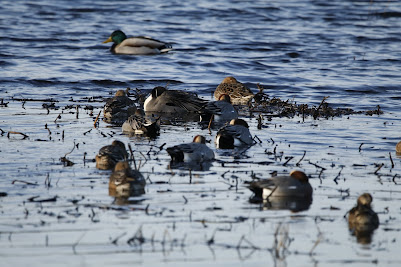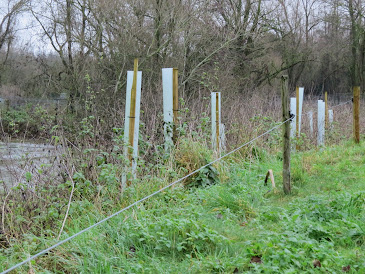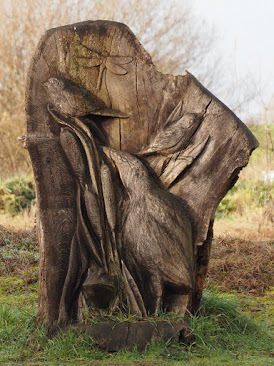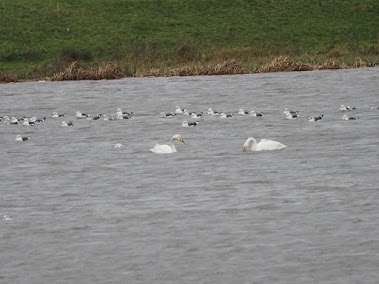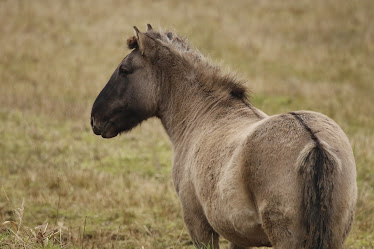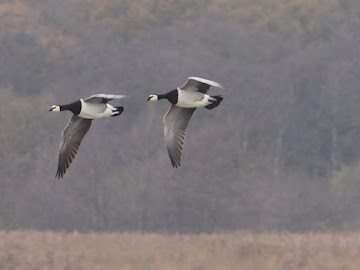So Christmas comes again, and with time spent with family, what better way to kill that time before the Christmas meal than a morning's ramble around North Warren. North Warren, although overlooked due to its sister reserve up the coast at Minsmere, is a reserve unique to the Suffolk coast, a vast hodgepodge of many differing habitats, home to rare birds. The reserve is a lot more low key than Minsmere, criss crossed by footpaths with a couple of observation points.
North Warren is probably the best example of grazing marsh in Suffolk, basically grassland that becomes seasonally flooded in winter. With grazing marshes the majority of the year its dry grassland with little bird interest, but come winter the area becomes inundated with water and the birds flock here in their thousands.
I started in the car park on the edge of Aldeburgh, and took the footpath north through the deserted caravan park, before meeting the old railway line, which cuts through the reserve. The walk along the old line is quite good for birds as it passes through areas of heath and thick scrub. A male BULLFINCH was a decent sighting among the more common smaller birds. A RED FOX was seen slinking away on the edge of some horse paddocks, an animal that's quite common here as they often hunt rabbits out on the heaths.
Soon, through breaks in the scrub, there were views onto South Marsh, the first area of wet grassland. Star bird here was a ringtail (female) HEN HARRIER, quartering the distant marshes, putting the ducks to flight. Its thinner wings and a browny-grey washed colour distinguished it from the more locally common marsh harriers. This bird probably originated from Europe, rather than the beleaguered population from the UK, as there are no grouse moors on the continent, so birds there are not shot.
There were plenty of DUCKS out on the marshes, mainly WIGEON, a duck which grazes like a goose, but also plenty of PINTAIL, who need wetter areas. North Warren is Suffolk's main location for this elegant duck with several hundred around the various flooded areas. There were plenty of other ducks about, a lot of them hidden in the tussocks of the grasslands.
Halfway through the reserve, a footpath crosses the grassland meeting the railway line, which cuts the marshes in two. From now on the grassland is called North Marsh, a concept that's easy to remember. On North Marsh there was less flooding and there were few ducks in this area. However they were replaced, strangely enough, by wild GEESE. The geese consisted mainly of BARNACLE GEESE with several hundred present, all feeding in on long horizontal line, birds originating from the feral population on the continent. With them were maybe a hundred or so WHITE FRONTED GEESE, proper wild geese, North Warren is the primary site for this species in Suffolk, and one of the top in the country.
The scrub around the railway line turns to woodland and eventually comes to the fens, a large area of reedbeds. At this time of year this area is quiet and there wasn't much to see. After that the path wanders out of the reserve and meets Thorpeness, first coming out onto the golf course, and then beside the meare, where in the surrounding alder trees there was a small flock of SISKIN, before eventually coming out on to the holiday village. From here it was a walk along the beach to Aldeburgh, giving good views of the marshes of North Warren as I walked back to the car.
A thoroughly enjoyable morning with lots of birds to see, North Warren really comes alive in winter. Anywhere else in the country it would be a stand out reserve, but being situated on the Suffolk coast means it is often overlooked when compared to its bigger nearby reserves. But with the right timing the reserve can be a great place to see large numbers of birds, and is therefore worth a visit at that time.
